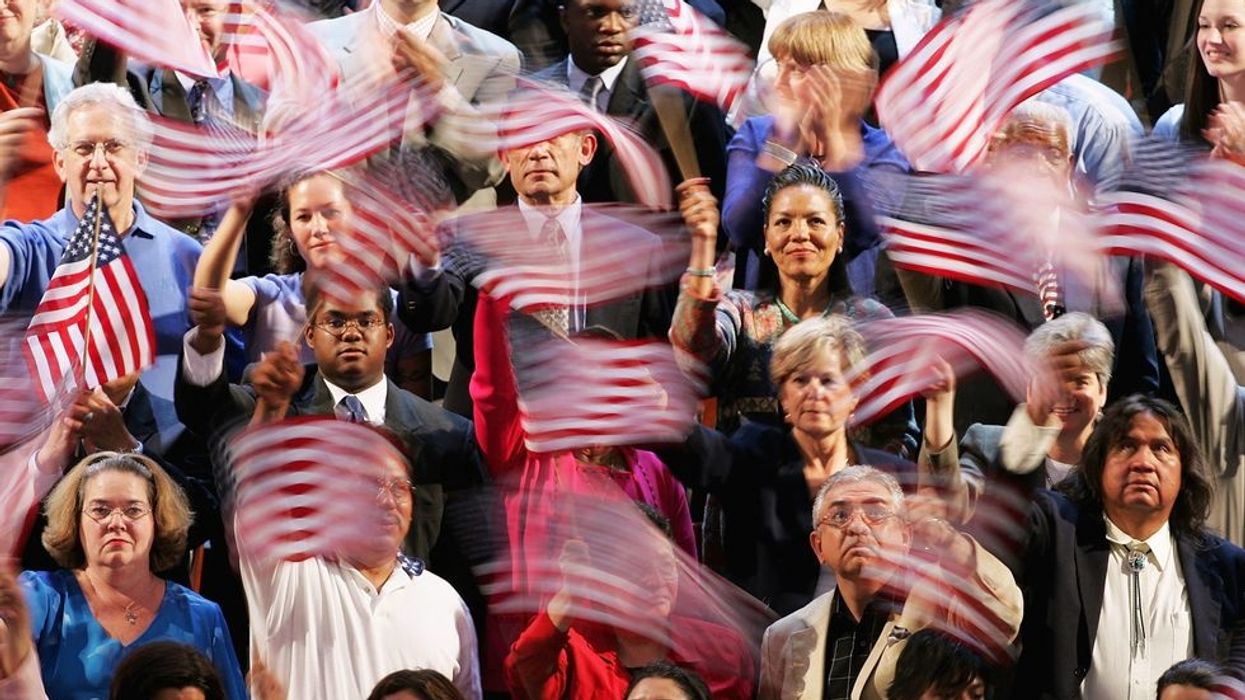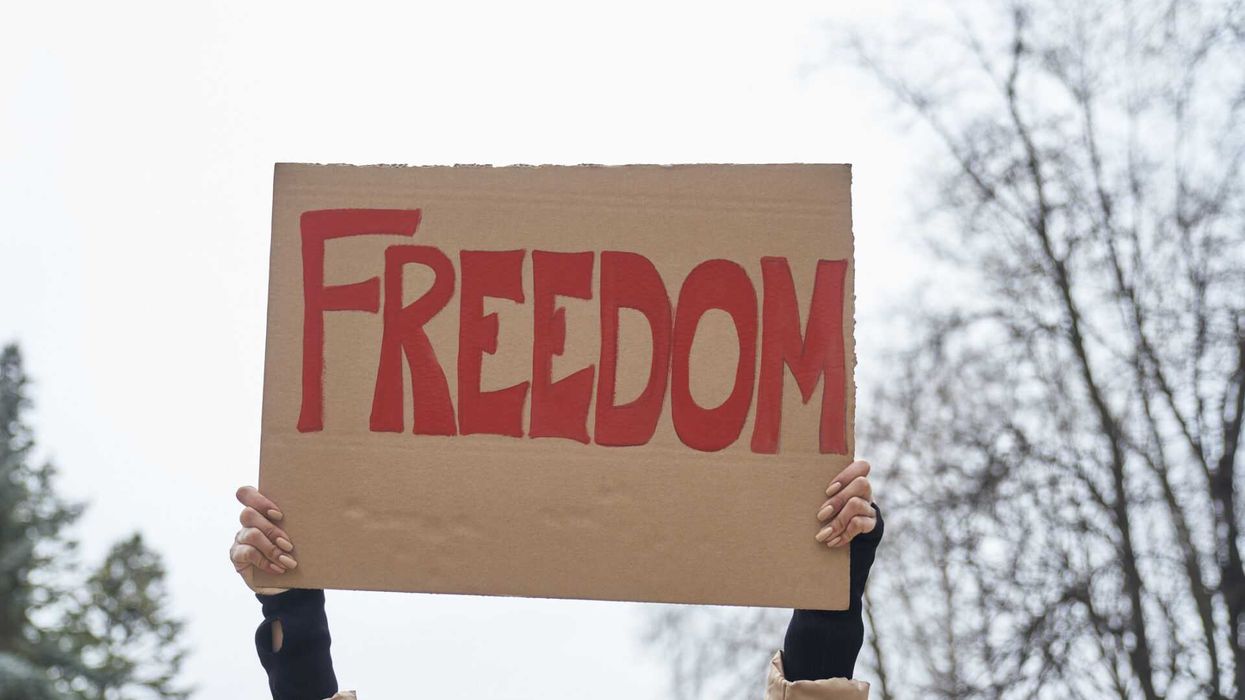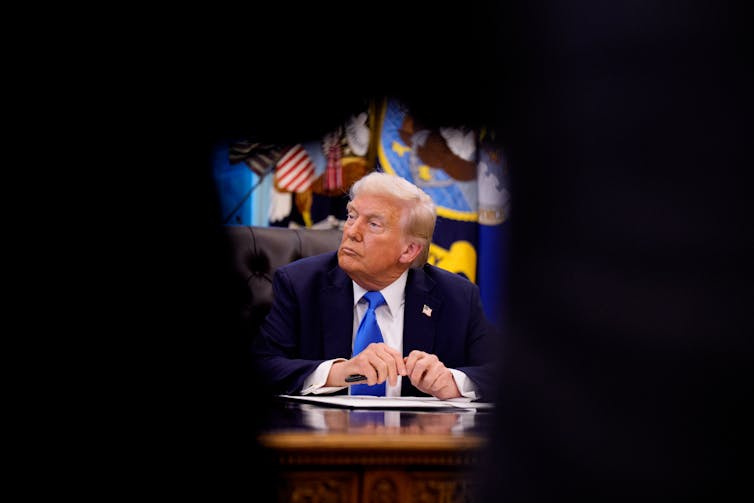Welcome to the latest edition of The Expand Democracy 5. With Rob Ritchie and Eveline Dowling’s help, we highlight timely links and stories about democracy at the local, national, and global levels. Today's stories include:
🧨 The psychology of political violence in America
💡 Reimagining the voter guide
📖 Creating citizens’ initiative assemblies
⚡ Allowing 17-year-olds to vote
🕓 This week’s timely links
In keeping with The Fulcrum’s mission to share ideas that help to repair our democracy and make it live and work in our everyday lives, we intend to publish The Expand Democracy 5 in The Fulcrum each Friday.
If you want to suggest a pro-democracy idea for coverage in The Expand Democracy 5, please use the contact form at Expand Democracy.
 The Psychology of Political Violence in America
The Psychology of Political Violence in America
*This piece is not related to the current protests in Los Angeles, as it takes a broader perspective. That said, my advice still stands: ask friends not to be violent.*
On June 1, the tranquil ambiance of Boulder's Pearl Street Mall was shattered when Mohamed Sabry Soliman, a 45-year-old Egyptian nationalist, launched a violent assault on a peaceful pro-Israel demonstration. Armed with Molotov cocktails, Soliman injured 15 individuals, including an 88-year-old Holocaust survivor. Soliman cited a desire to harm those he perceived as "Zionist people." His actions underscore a disturbing trend of politically motivated violence that has been escalating across the U.S., with many fearing it could get worse without greater attention to how to mitigate the threat.
This incident is not isolated. The U.S. has seen a surge in hate crimes targeting specific religious or ethnic groups, including the May 21st murder of two Israeli embassy staff outside the Capital Jewish Museum in D.C. These attacks, amid heightened tensions from the Israel-Hamas conflict, highlight that while such violence must be condemned, it can stem from political voicelessness. Washington Post columnist Shadi Hamid wrote about the genocide of Gaza's Palestinian children, who lack political recourse in the U.S. The concerns around this are valid, yet most Congress members from both major parties support military aid to Israel and defend its actions.
The attack on Congress and the U.S. Capitol on January 6, 2021, was similar in nature. Fueled by a White House demagogue promoting “Stop the Steal” lies, the rioters felt their views were blocked by state and federal courts, state legislators, and Congress. Their violence could have escalated further without the bravery of the U.S. Capitol police, yet it led to several deaths and injuries to as many as 140 officers. President Trump’s election lies are now embraced by his party, as he pardoned the January 6th rioters on his first day in office. His supporters now have political representation in the nation’s highest offices, but it comes with an inherent volatility if they don’t like the outcome of the next national election.
One approach to maintaining activist passion in politics is providing representation, which is more likely in proportional systems than in U.S.-style winner-take-all elections. But we need not wait for structural reforms to address the root causes of radicalization and to develop comprehensive strategies against domestic extremism. As communities face the impact of such attacks, a balanced approach is required to ensure security while upholding civil liberties. Investing in outreach, education, and early intervention programs can prevent the spread of extremist ideologies.
[Source: The Religious Action Center]
The Psychology of Political Violence: When Fear Becomes Force: The attack in Boulder, CO, was not just an act of hatred. It was also an expression of deep psychological insecurity. To understand how ordinary individuals commit extraordinary violence, we must examine what political psychologists describe as defensive extremism: a process by which individuals lash out violently in response to a perceived loss of control, belonging, or identity.
Research shows that political violence is often rooted less in ideology than it is in psychological distress and identity threat (see Huddy, Mason, and Arroe, 2015). When people experience social, economic, or cultural instability, they often interpret political change as an attack on their sense of self (see Liliana Mason’s 2018 book Uncivil Agreement). In this vulnerable state, violence becomes a perverse attempt to restore agency and impose order on a world that feels chaotic. This dynamic is especially potent among (1) socially isolated individuals who lack strong community ties or identity anchors, (2) contexts of rapid change where longstanding social hierarchies or belief systems feel upended, and (3) online echo chambers where grievances are magnified and weaponized.
Other research led by Katarzyna Jasko examines how the “quest for significance” reveals how people who feel humiliated, excluded, or powerless are more likely to adopt extreme ideologies that offer dignity and clarity through action, including violent action (International Society of Political Psychology, 2014). Moghaddam’s “staircase to terrorism” model explains how personal grievances and perceived injustices escalate through stages of cognitive narrowing and moral justification, ultimately leading some individuals to see violence as the only meaningful choice (American Psychologist, 2005). In the Boulder case, the attacker expressed a desire to “send a message” and “hurt Zionist people,” reflecting the classic signs of externalized blame and moralization of violence seen in radicalized individuals.
As political violence rises in the U.S., understanding the distinct psychological processing types is crucial. Jonathan Ludwig’s Unforgiving Places, based on FBI homicide data, shows nearly 80% of American murders are expressive, not instrumental. These acts aren’t calculated for gain; they’re emotional eruptions, “a match struck in passing,” as Ludwig writes. Driven by frustration, alienation, and the need to find meaning amid perceived threats, expressive violence is spontaneous and personal. Ludwig links this violence to System 1 thinking: a rapid, reactive mode that views the world in binaries, asking “what does this have to do with me?”, and prioritizing threats over possibilities. When people are overwhelmed by fear, outrage, or perceived injustice, especially in polarized environments, this mentality can escalate political issues and turn personal grievances into public violence.
Framing these attacks as psychologically defensive doesn’t excuse them, but it does help us intervene more effectively. Preventing political violence requires more than surveillance or enforcement. It demands early interventions that build belonging, mitigate identity threats, and inoculate individuals against dehumanizing narratives. Programs focused on community engagement, online radicalization prevention, and trauma-informed education are key to addressing the root causes, not just the symptoms, of domestic extremism. In a moment when political violence is becoming more individualized, improvised, and ideologically diverse, understanding its psychological roots is essential to preserving a healthy democracy. We can all help by speaking out against violence whenever friends and neighbors suggest it.
Resources:
- Journal of Democracy, October 2024 article: How to Prevent Political Violence by Rachel Kleinfeld and Nicole Bibbins Sedaca
- The Ash Center’s August 2024 event, Political Violence in America: Causes, Consequences, and Countermeasures
- Political Violence — Resources from the Democracy Funders Network
 Reimagining the Voter Guide for a New Era of Engagement💡
Reimagining the Voter Guide for a New Era of Engagement💡
In 2024 and beyond, civic groups are realizing that reaching voters, especially young, new, and disengaged ones, requires more than simply sending out dense sample ballots and FAQs. A new generation of voter guides and education tools is emerging: visual, mobile, personalized, and culturally relevant. The best of these not only inform voters but also invite them in.
A recent roundup by Nonprofit VOTE offers 24 creative ideas to engage voters, including pop-up voter registration events, collaborations with local artists, and co-branded guides designed with trusted community institutions. The emphasis: meet people where they are, physically and emotionally, and use trusted messengers to increase turnout in overlooked communities.
Meanwhile, the Center for Civic Design lays out clear best practices for creating effective, inclusive voter guides. Their latest field guide encourages election officials and nonprofits alike to:
- Focus on actionable, accessible information (e.g., where, when, and how to vote).
- Avoid legal jargon in favor of clear, visual language.
- Tailor guides to different reading levels and languages, and include sample ballots and candidate statements to clarify the process.
This matters most for younger voters. According to the Center for Tech and Civic Life’s youth engagement research and Aristotle’s Gen Z outreach guide, young people want:
- Peer-to-peer content and videos that break down how voting connects to issues they care about (i.e., short explainers, meme formats, or Instagram Reels).
- Interactivity and immediacy via QR codes, personalized reminders, and AI chat-based guides.
- Messaging that emphasizes empowerment and self-expression instead of guilt or doom.
Together, these approaches indicate a modern voter engagement model that resembles an invitation to a community project rather than a bureaucratic transaction. As we approach 2026 and 2028, Expand Democracy will be watching and supporting groups that view voter education not merely as a requirement but as a creative discipline grounded in design, storytelling, and a sense of belonging.
 Rebuilding Direct Democracy with Citizens’ Initiative Assemblies💡
Rebuilding Direct Democracy with Citizens’ Initiative Assemblies💡
[Source: Harvard Law Today]
This month’s Harvard Law Review features a compelling student note that confronts a growing crisis in American democracy: the broken ballot initiative process. Once a proud Progressive Era reform to give voters a direct voice, today’s initiative system is increasingly dominated by big money, special interests, and confusing policies that voters often don’t fully understand. And yet the initiative gives voters direct power to pass policies they support. Can we fix it instead of eliminating it, and create conditions that could make it viable in more states?
The article, titled “Putting the Initiative Back Together”, proposes a bold fix: create Citizens’ Initiative Assemblies, permanent, randomly selected groups of everyday people who would deliberate on proposed ballot initiatives, offer guidance to voters, and even help shape what gets on the ballot in the first place. Drawing from international examples in Ireland and Canada, and Oregon’s own Citizens’ Initiative Review, the paper argues these deliberative bodies could restore trust, transparency, and legitimacy to the initiative process, especially as more states move to restrict direct democracy.
At a time when legislatures in multiple states are actively trying to roll back ballot access, this idea points to a future where more voters, not fewer, have a say in shaping the laws that govern them. Please send us your own ideas about how we can best have initiative and referendum rights in the 21st century.
 Expanding the Franchise for 17-Year-olds in Primaries⚡
Expanding the Franchise for 17-Year-olds in Primaries⚡
Across the country, a quiet but growing reform is reshaping who gets a say in our democracy: allowing 17-year-olds to vote in primaries so long as they’ll be 18 by the general election. Advocates argue this simple change can have outsized impacts: strengthening youth engagement, increasing turnout, and ensuring that young voters have a voice in deciding who appears on their November ballot. It is also eminently logical: if a citizen is eligible to elect someone in November, they should have the opportunity to vote in primaries and pick the nominees for that election.
According to Ballotpedia, 27 states and Washington, D.C., now allow some form of 17-year-old primary voting. In many cases, this applies to presidential primaries, but in others, it also includes 19 states for congressional and state primaries. This means millions of high school seniors, many of whom are politically aware and civically engaged, can participate in shaping the choices available in general elections.
FairVote notes that this reform can be especially effective when combined with civic education and pre-registration programs. In Maryland, for instance, pre-registered 17-year-olds voted at higher rates than older first-time voters in 2020, thanks in part to targeted outreach and school-based engagement. Allowing 17-year-olds to vote isn’t just symbolic; it has tangible results.
The principle is simple: if eligible to vote in November, you should have a say in the ballot. States seeking to boost Gen Z civic participation find this reform appealing due to its bipartisan support, low cost, and measurable impact. With the 2026 midterms approaching, expanding primary voting rights to 17-year-olds might be one of the most straightforward and impactful steps we can take.
[Teens 16 and 17 get to vote in Alameda County school board races. Source: LA Times]
 Timely Links
Timely Links
We close The Expand Democracy 5 with notable links:
- The true danger of Trump’s Tariffs: Michael McConnell, director of Stanford’s Constitutional Law Center and a former Bush-appointed federal judge, in the New York Times: “Urgent necessity is the intelligible principle that defines an emergency. If Mr. Trump wants Congress to give him blanket authority to impose tariffs to combat ‘large and persistent trade deficits,’ which by his own account happened over generations, he should ask Congress to expressly grant him such broad authority. Any other interpretation would allow the president to ignore the limiting terms of the statute if he finds it inconvenient. That would not be the constitutional republic the founders designed.”
- White House Pushes Texas to Redistrict, Hoping to Blunt Democratic Gains: “Trying to push through new maps would almost certainly set off a bruising political fight of the sort last seen in 2003, when Representative Tom DeLay, a senior Republican House leader from Texas, forced through a redrawing of the Texas political maps. With Republicans now holding a 25-to-12 advantage in the state’s House delegation over Democrats, those opportunities [for major gains] would be more limited…Still, those pushing for the plan believe that Republicans could potentially pick up as many as four or five House seats in 2026.”
- RCV Team Releases Portland City Council Survey: The League of Women Voters of Portland (OR) in May released a report on comprehensive interviews with candidates in the city’s first proportional RCV election. “The interviewees delivered a strongly positive assessment of multi-winner RCV overall. In particular, it was credited with fulfilling its promise of attracting and electing more diverse candidates, reducing partisan rancor and rhetoric, and giving voice to voters who traditionally have had little representation in city government.”
- All Voting is Local’s Vision for the Future of Voting: “Our agenda outlines actionable solutions to ensure the following: (1) every American can get on the rolls and stay on the rolls; (2) every American can vote when, where, and how it works for them—in under 30 minutes (3) partisan interference in vote counting and certification is stopped.
- Testimony from Rob Richie to New York City Charter Commission: Rob was asked to comment in particular on all-candidate primaries, which is his focus in the testimony and several pages of appendices. “Let me start by ranking reform options without factoring in legal and political considerations: 1st choice - hold a single RCV election in November, with three-member districts for city council and a short turnaround mayoral runoff if no candidate earns 40% of first choices; 2nd choice - hold an Alaska-style Top Four primary system, with RCV in November; and 3rd choice - Adopt Maine’s model of RCV in the primary followed by RCV in November.”
- Ranked choice voting is a women’s issue: From Lorissa Rinehart, The Female Body Politic. “Traditional winner-take-all voting systems often work against women and other underrepresented candidates in subtle but powerful ways. When multiple candidates from similar ideological backgrounds want to run, it is almost always the woman who is told, ‘Wait your turn’ and ‘You’ll spoil the election for everyone…’ RCV can help dismantle these structural barriers in several key ways.”
- Reformers' dilemma: Which Pro Rep method is best for US democracy?: From Steven Hill, Democracy SOS. “The fundamental dilemmas of modern representative democracy do not always lend themselves to easy solutions, or to simple assessments of which electoral system design will work best… It is incumbent upon reform advocates to do the hard work of drafting their electoral plan(s) with enough concrete specificity that addresses the known problems of US democracy within the well-known, path-dependent constraints of local, state and national traditions, culture and history, as well as the pros and cons of each PR method.





















